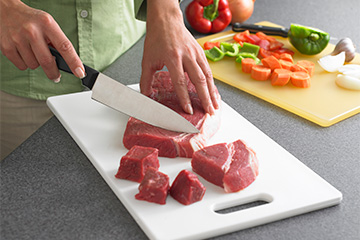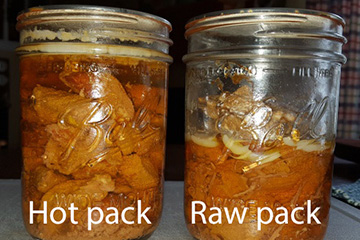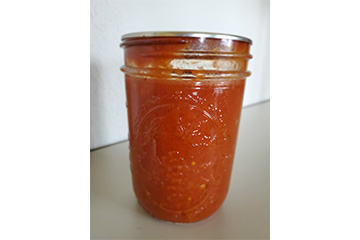
Canning Meats

Freezing isn’t the only method used to extend the life of meats. Meats, such as beef, pork, venison, bear, lamb, or veal, can be canned in pint or quart jars. These can be stored and enjoyed for up to at least 12 months.
Prepare meats for canning by:
- Trimming visible fat from wild game and other meats to avoid off-flavors
- For strong- flavored wild game, soak meat in brine water with 1 TBSP of salt per quart of water for one hour to reduce. Rinse well.
- If canning ground or chopped venison, add animal fat (such as pork fat) to leaner cuts of meat to aid in the canning process (also adds flavor).
- A raw or hot pack method can be used to pack strips, cubes, or chunks of meat into jars. However, the hot pack method is preferred for best quality.
- When hot packing, cook meats by boiling, steaming, or baking meat until about 70% cooked. Pack pieces into jars loosely, top with meat stock, boiling broth, water or tomato juice.
- Regardless of pack method, leave 1 inch of headspace at the top of the jar for meat and run a plastic spatula or knife between food and jar to remove air bubbles. Wipe the jar rim with a clean cloth before securing the lid and band.
Meats must be processed in a pressure canner to kill harmful bacteria that may be found in meat. Processing times are affected by the form of the meat, size of the jar, and the local altitude of the preserver. Find recommended processing times at Preparing and Canning Poultry, Red Meats and Seafoods.
Canned Bear, Beef, Lamb, Pork, Veal, or Venison strips, cubes, or chunks

Ingredients:
- Meat
- Salt (optional)
- Soak strong-flavored wild meats in brine containing 1 Tablespoon of salt per quart of water for 1 hour. Rinse and remove large bones.
- Pack using the hot or raw pack method:
Hot pack: Boil, bake, or brown meat until about 70% cooked. Pack hot meat loosely into jars, cover with boiling broth, meat drippings, water or tomato juice, leave 1-inch headspace, and secure lid and band.
Raw pack: Fill jars loosely with meat pieces, add 2 tsp of salt per quart to the jar if desired, leave 1-inch headspace, and secure lid and band. - Process quarts in a dial-gauge pressure canner for 90 minutes at 11 lbs of pressure for elevations up to 2,000 ft., 12 lbs for elevations between 2,001-4,000 ft., 13 lbs for elevations between 4,001-6,000 ft, and 14 lbs for elevations between 6,001-8,000 ft.
Or process in a weighted-gauge pressure canner for 90 minutes at 10 lbs of pressure for elevations up to 1,000 ft and 15 lbs at elevations of 1,001 ft or higher.
Source: National Center for Home Food Preservation: Preparing and Canning Poultry, Red Meats and Seafoods.
Safe Methods for Canning Soup at Home

Ahh, nothing tastes better than a bowl of hot homemade soup on a chilly fall day. Many food preservers would enjoy reproducing soups found in the grocery store or other eating establishments. However, there are some commercially prepared foods that just cannot be reproduced safely by home canners. Creamed soups are not suitable for home canning because their ingredients interfere with the proper transfer of heat during the processing step and can result in food borne illness. Freezing cream-based soups is a safer option.
Some Tips to Keep in Mind When Home Canning Soups:
- Soups always need to be pressure canned because most have meat and/or low acid ingredients. Keep in mind to adjust processing for your altitude.
- Do NOT add noodles, rice, flour, cream, or any milk or thickeners—these can prevent heat penetration to the center of the jar during processing. All of these can be added when heating the soup to serve.
- If you are using dried beans or peas, they must be cooked prior to canning.
- The only ingredients you should use are ingredients that are safe to can in its plain form. For example, since cabbage does not have a tested method of canning by itself, it is not considered an acceptable ingredient.
- If you are canning soup with seafood, you will need to process either pints or quarts for 100 minutes.
- Be sure to use a recipe that is newer than 1994 and is a USDA tested recipe! Ask your local extension office if you have questions about your recipe source and if the soup is recommended for home canning.
Sources:
Penn State Extension, “Preserving Soup Safely,” updated November 2017.
National Center for Home Food Preservation, “Burning Issue: Canning Homemade Soups,” Slightly revised May, 2019. (No longer available online.) As an alternative, see Soups.
K-State Research and Extension, “Preserve It Fresh, Preserve It Safe-Vegetables," MF1181, December, 2015.